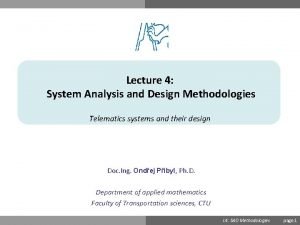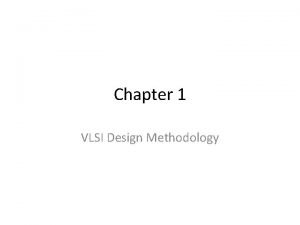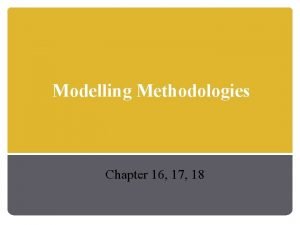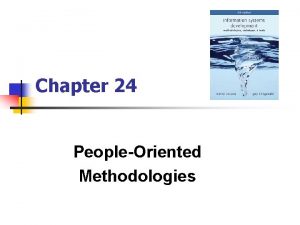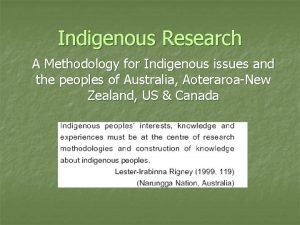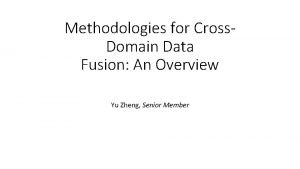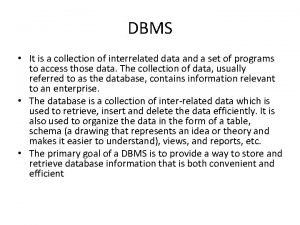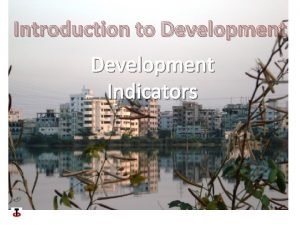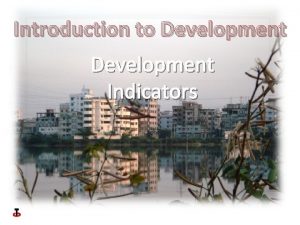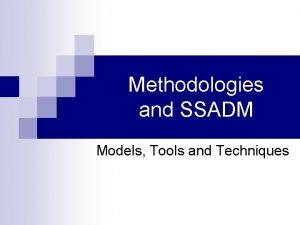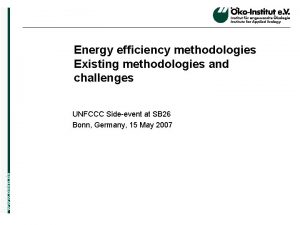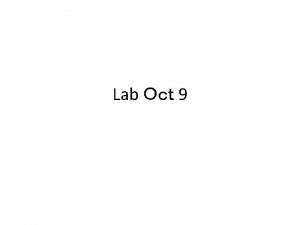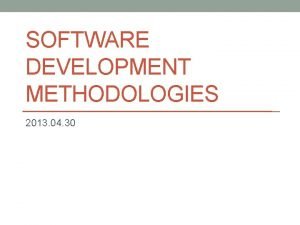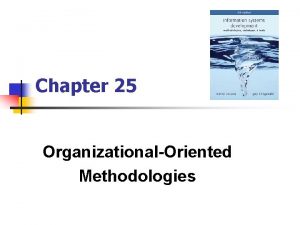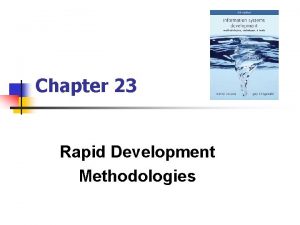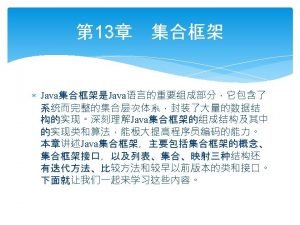Identification of indicators and methodologies for information collection


















- Slides: 18

Identification of indicators and methodologies for information collection SIS National Workshop Monrovia 14 June 2018

Principles Key objectives that define high social and environmental performance Criteria Conditions that must be met related to processes and impacts to deliver on principles Indicators Quantitative or qualitative information to show progress achieving a criterion

Principles Key objectives that define high social and environmental performance Criteria Conditions that must be met related to processes and impacts to deliver on principles Indicators Verifiers Quantitative or qualitative information to show progress achieving a criterion - a variable or component Specific information used to assess compliance or performance

Principles Criteria UNFCCC Cancun safeguards with minor adaptation for Liberia if needed Conditions in Liberia’s context that must be met related to processes and impacts meet UNFCCC safeguards Documents used as input for criteria • Analysis of Liberian policies, laws and regulations vs Cancun safeguards • World Bank FCPF – Environmental Social and Management Framework (ESMF) • Gender Policy of Green Climate Fund • Liberia National Interpretation of RSPO • FLEGT Voluntary Partnership Agreement • Pro-Poor Agenda for Prosperity and Development (PAPD) • SESA outcomes

Principles Principle C: REDD+ actions respect for the knowledge and rights of members of local communities Criteria C. 1 Rights to lands and resources relevant to REDD+ actions are identified and mapped Indicators Verifiers Indicator C. 1. 1: # maps of rights to land resources supported by REDD+ A digital map (shape files) for project implementation area, showing community land use, and all concessions in the area eg forestry, mining, agriculture

Types of indicator for SIS • Structures – Policies, laws and regulations that address the safeguards • Processes - measures implemented to respect the safeguards • Outcomes - environmental and social changes resulting from REDD+ implementation • Qualitative - yes-no, presence-absence or high-medium-low • Quantitative - quantity, trend, rate etc.

Types of indicator for SIS - examples • Structures – Policies, laws and regulations that address the safeguards • Indicator B. 5. 1: % of REDD+ governance structures with published TOR and internal regulations • Processes - measures implemented to respect the safeguards • Indicator E. 3. 1 # Projects that have completed environmental screening and classification, conducted ESIA if required and have approved and implemented ESMP or other plans as required • Outcomes - environmental and social changes resulting from REDD+ implementation • Indicator E. 4. 1 # of households with diversified livelihoods

Types of assessment - examples • Qualitative - yes-no, presence-absence or high-medium-low Indicator D. 4. 1 Level of information dissemination and understanding of people (including women and youth) about REDD+ activities in their area • For each project • information disseminated to communities - High, Medium, Low • level of understanding of entire community, women, youth - High, Medium, Low • Quantitative - quantity, trend, rate etc. Indicator E. 5. 1 # people with improved food security (more food, more nutritious, available throughout the year) through REDD+ actions • For each project: change in food consumptioon pattern over life of project (levels of protein, carbohydrate, calories)

Reminder of Liberia National REDD+ Strategy options 1. Reduce forest loss from pit sawing, charcoal production and shifting agriculture 2. Reduce impact of commercial logging 3. Complete and manage a network of Protected Areas 4. Prevent or offset clearance of high carbon stock and high conservation value forest in agricultural and mining concessions 5. Fair and sustainable benefits from REDD+

Potential implementation activities/organisations Projects • Support organizations (NGOs) and community organizations for community livelihoods for activities to Reduce forest loss from pit sawing, charcoal production and shifting agriculture • Commercial concessions and Community Forest Management Agreements for activities to Reduce impact of commercial logging • Regional Forestry Office and supporting NGOs for activities to Complete and manage a network of Protected Areas • Commercial concessions for activities to Prevent or offset clearance of high carbon stock and high conservation value forest in agricultural and mining concessions National REDD+ strategy • FDA/REDD Implementation Unit

Example indicator Criterion B. 4 REDD+ strategies, plans and actions promote and enhance gender equality Indicator B. 4. 1 - Percentage of women and men participants in REDD+ activities and decision-making Verifier (what specific information) - Numbers of women and men participating in each REDD+ activity including consultations and implementation, and in governance bodies Source of information (where is information found) - Annual reports of REDD+ activities and reports of meetings of governance bodies Methodology (how is information collected and performance assessed) - Require reporting on numbers of women and men in all activities and meetings. Calculate annual average % women participants for each project and governance body Who collects information - Project lead Who validates/ensure quality of information – • Alternative Livelihood Committee or District Development Committee at local level? • County Development Committee or Regional Inter. Agency Task Team (RIAT) at regional level? • REDD+ Technical Working Group/sub-group focusing on safeguards at national level?

Group work 1 – Review of Indicators • Divide into 3 groups – Group 1: Principle A on consistency with policies and internatonal agreements – Group 2: Principle B on transparent governance structures – Group 3: Principle C on respect for rights of local communities • Facilitator from CI/SADS will – Guide through indicators, verifiers, methodologies, who collects and validates – Ask questions on outstanding issues – Collect your feedback Aim is to ensure SIS is feasible, adapted to Liberian realities and meets objectives

Group work 2 – Review of Indicators • Divide into 3 groups – Group 1: Principle D on stakeholder participation – Group 2: Principle E on avoiding harm and delivering benefits – Group 3: Principles F on permanence Principle G on leakage • Facilitator from CI/SADS will – Guide through indicators, verifiers, methodologies, who collects and validates – Ask questions on outstanding issues – Collect your feedback Aim is to ensure SIS is feasible, adapted to Liberian realities and meets objectives


Expectations for ESIA process • A 4. 2 – require conflict analysis • C 3. 1 – assess costs and benefits for all stakeholder groups • C 6. 1 – identify, map and take measures to protect sites of cultural importance • E 1. 1 – identify, map and take measures to protect High Conservation Value and High Carbon Stock • E 3. 3 – require Pest Management Plans for projects using pesticides

High Conservation Values (HCV) HCV 1 Concentrations of biological diversity including endemic species, and rare, threatened or endangered species, that are significant at global, regional or national levels. HCV 2 Landscape-level ecosystems and mosaics. Intact forest landscapes and large landscape-level ecosystems and ecosystem mosaics that are significant at global, regional or national levels, and that contain viable populations of the great majority of the naturally occurring species in natural patterns of distribution and abundance. HCV 3 Rare, threatened, or endangered ecosystems, habitats or refugia. HCV 4 Basic ecosystem services in critical situations, including protection of water catchments and control of erosion of vulnerable soils and slopes. HCV 5 Sites and resources fundamental for satisfying the basic necessities of local communities or indigenous peoples (for livelihoods, health, nutrition, water, etc. . . ), identified through engagement with these communities or indigenous peoples. HCV 6 Sites, resources, habitats and landscapes of global or national cultural, archaeological or historical significance, and/or of critical cultural, ecological, economic or religious/sacred importance for the traditional cultures of local communities or indigenous peoples, identified through engagement with these local communities or indigenous peoples.

High Carbon Stock (HCS)

Thank you!
 System analysis and design methodologies
System analysis and design methodologies Types of quantitative research designs
Types of quantitative research designs Y chart
Y chart Wikipedia agile project management
Wikipedia agile project management Define the relationship chapter 16
Define the relationship chapter 16 Task model
Task model Domain closure in software testing
Domain closure in software testing What is indigenous research
What is indigenous research Business performance management methodologies
Business performance management methodologies Methodologies for cross-domain data fusion: an overview
Methodologies for cross-domain data fusion: an overview Presumptive identification vs positive identification
Presumptive identification vs positive identification Landsat collection 1 vs collection 2
Landsat collection 1 vs collection 2 Documentary payment
Documentary payment Interrelated data examples
Interrelated data examples Formuö
Formuö Typiska novell drag
Typiska novell drag Tack för att ni lyssnade bild
Tack för att ni lyssnade bild Vad står k.r.å.k.a.n för
Vad står k.r.å.k.a.n för Varför kallas perioden 1918-1939 för mellankrigstiden?
Varför kallas perioden 1918-1939 för mellankrigstiden?
